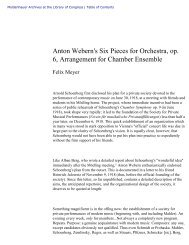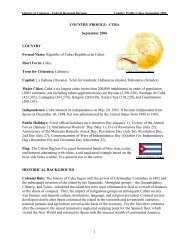1 - American Memory
1 - American Memory
1 - American Memory
You also want an ePaper? Increase the reach of your titles
YUMPU automatically turns print PDFs into web optimized ePapers that Google loves.
172<br />
Hawaii's visible—or commodity—exports are mainly sngar and pineapple, al-<br />
though there is a considerable volume of other products that we produce and<br />
ship to the Mainland U.S.<br />
8U0AB<br />
In a normal year we will ship to the Mainland approximately 1,200,000 tons<br />
of raw sugar.<br />
PINEAPPIE<br />
Pineapple production Is somewhat more variable than sugar production. In re-<br />
cent years, pineapple production, most all of which is shipped to the Mainland,<br />
has been in the range of 17 million cases of solid fruit, 11 million cases of juice,<br />
and 1 million of juice concentrates. It is expected that In 1973 Hawaii will addi-<br />
tionally ship to the Mainland close to 70 million pounds of fresh pineapple.<br />
0ABMERT8<br />
No precise figures are available, but It is estimated that approximately fl5 mil-<br />
lion of garments made in Hawaii go the Mainland markets each year.<br />
Since 1964, Hawaii has more than doubled her outshipments of fresh papaya<br />
to the Mainland. Now close to 10 million pounds of fresh papaya are air flown to<br />
the Mainland each year and local producers look to continued expansion of this<br />
market.<br />
While Mainland marketings comprise between 40 and 45 percent of the volume<br />
of Hawaii's fresh papaya sales, the return on these marketings accounts for 60<br />
percent of papapya receipts.<br />
In addition to fresh fruit marketings, Hawaii ships close to 1 million pounds<br />
of processed papapya products to the Mainland each year.<br />
MACADAMIA NUTS<br />
In 1971, 1.5 million pounds of processed macadamla nuts went to Mainland<br />
markets—double the 15)64 volume of shipment.s. With the tremendous planting of<br />
new trees in recent years, as the orchards mature and as more trees reach the<br />
bearing stage, the increase in macadamla exports to the Mainland should be even<br />
greater during this decade.<br />
FLOWEBB AND NUB8ERT PRODUCTS<br />
Out-of-state sales of flowers and nursery products were valued at $2.7 million<br />
in 1971. The sale of anthuriums accounted for 56 percent and orchids 28 percent<br />
of Hawaii's horticultural exports. Although no figures are available. It is known<br />
that the overwhelming majority of these exports go to the Mainland.<br />
Anthurlum outshipments to the Mainland, doubling In the past six years,<br />
totaled 6.5 million flowers last year. Mainland sales represented 49 percent of<br />
Hawaii's anthurlum market In 1970 and 65 percent in 1971.<br />
Hawaii's invisible exports—services sold locally for Mainland dollars—con-<br />
sist primarily of .sales to the Federal government (mainly the defense agencies)<br />
and to Mainland visitors.<br />
DEFENSE<br />
About one-third of all defense agency expenditures in Hawaii are for the pur-<br />
chase of commodities or services from outside contracting agencie.s. This amounts<br />
to between $200- and $300-milllon a year, and a fairly large fraction of this is for<br />
contract construction. Shipping strikes, which interfere drastically with the flow<br />
of building materials to the islands, cause a very large loss in revenue from this<br />
source.<br />
visrroits<br />
Approximately 1.6 million visitors came to Hawaii last year from the Mainland<br />
U.S., staying an average of 9..S days each (14.9 million visitor days) and spending<br />
while in Hawaii approximately $41 per person per day ($607 million). There are<br />
various ways to measure the impact of this on Hawaii's economy, but our best



![Albert Einstein Papers [finding aid]. Library of Congress. [PDF ...](https://img.yumpu.com/21604228/1/190x245/albert-einstein-papers-finding-aid-library-of-congress-pdf-.jpg?quality=85)





![American Colony in Jerusalem Collection [finding aid]. Library of ...](https://img.yumpu.com/17941275/1/190x245/american-colony-in-jerusalem-collection-finding-aid-library-of-.jpg?quality=85)



![Piccard Family Papers [finding aid]. - American Memory - Library of ...](https://img.yumpu.com/17941234/1/190x245/piccard-family-papers-finding-aid-american-memory-library-of-.jpg?quality=85)


